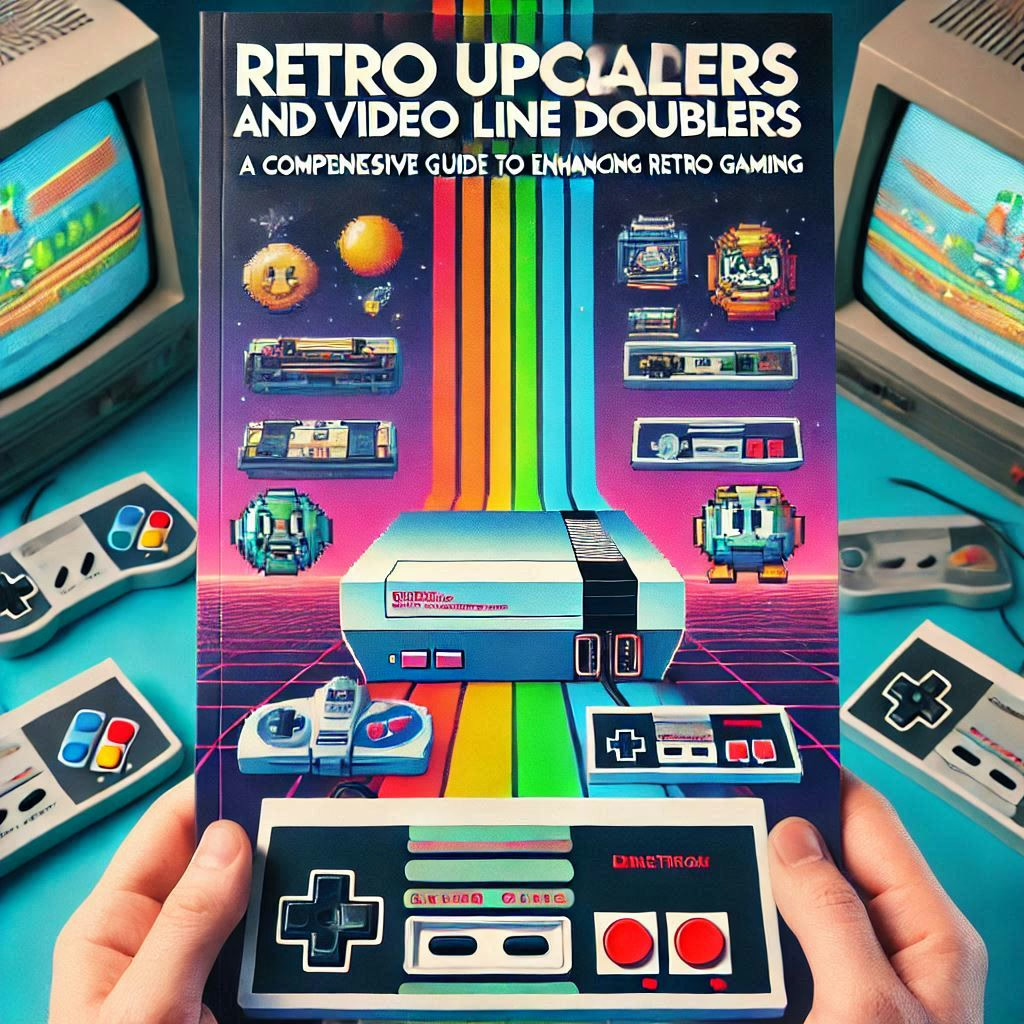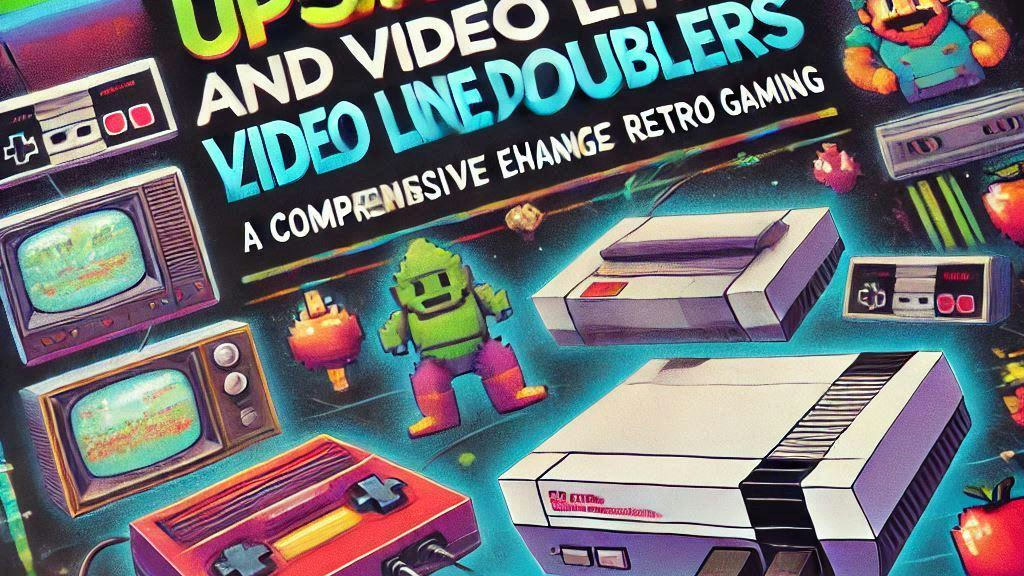Overview:
A comprehensive guide to enhancing retro gaming through the use of video line doublers and upscalers. It highlights the resurgence of retro gaming, the challenges with old consoles on modern displays, and recommends various upscalers like the Retro-5X Pro, Retrotink 4K, and more. Key features like compatibility, resolution, low latency, and advanced customization are discussed, aiding users in selecting the right upscaler for their needs. Additionally, community support, price considerations, and the importance of firmware updates are emphasized to ensure an enhanced retro gaming experience.
Retro gaming has seen a significant resurgence in recent years, with enthusiasts eager to relive the golden age of video games. However, one of the primary challenges faced by retro gamers is the compatibility of classic consoles with modern high-definition televisions. The low-resolution output of older consoles often results in a subpar visual experience on contemporary displays. This is where video line doublers and retro upscalers come into play, offering a solution to enhance the image quality of retro games.
Video line doublers and upscalers are devices designed to convert the low-resolution signals from retro consoles into higher resolutions suitable for modern HDTVs and monitors. These devices not only improve the visual clarity but also reduce input lag, providing a smoother and more enjoyable gaming experience. The market offers a variety of upscalers, each with unique features and compatibility options, making it essential for gamers to choose the right one for their specific needs.
One of the most popular and highly recommended upscalers is the Open Source Scan Converter (OSSC). The OSSC uses FPGA technology to deliver a delay-free line multiplier, supporting a wide range of resolutions and refresh rates. It is compatible with numerous retro consoles, including the Sega Genesis, Super Nintendo, and PlayStation 1, making it a versatile choice for retro gaming enthusiasts.
Another notable option is the RetroTINK series, which offers a range of devices from affordable line doublers to fully featured scalers with CRT mask emulation and high-resolution output. The RetroTINK devices are known for their plug-and-play simplicity, requiring no extensive setup or tweaking, making them ideal for gamers who prefer ease of use.
For those seeking a more advanced solution, the XRGB Mini Framemeister remains a popular choice despite its higher price point. Known for its excellent image quality and extensive customization options, the Framemeister is particularly favored by gamers who want to fine-tune their gaming settings for the best possible experience.
In addition to these, there are other upscalers like the RAD2x cables, which offer a straightforward, plug-and-play solution for classic consoles. These cables are based on RetroTINK technology and are an excellent choice for both beginners and those looking for a secondary solution.
Choosing the right upscaler involves considering factors such as compatibility with your console, the quality of the output signal, and any additional features that may be important to you. It is also crucial to select a reputable brand with a proven track record of producing high-quality products. By investing in a suitable upscaler, retro gamers can significantly enhance their gaming experience, bringing their favorite classic games to life on modern displays.

Overview of Video Line Doublers and Upscalers
Video line doublers and upscalers are essential tools for retro gaming enthusiasts who wish to play classic console games on modern displays. These devices enhance the video output of older gaming systems, which were originally designed for CRT (Cathode Ray Tube) televisions, by converting and improving the signal for compatibility with contemporary high-definition (HD) and ultra-high-definition (UHD) screens.
Key Features of Video Line Doublers and Upscalers
Outputs and Inputs
Modern video line doublers and upscalers, such as the RetroTINK-4K, offer a variety of output and input options to accommodate different retro consoles and display types. Common outputs include HDMI, which is standard for modern TVs and monitors. Inputs often include composite, S-Video, component, and RGB, ensuring compatibility with a wide range of retro gaming systems.
Analog Video Processing
Analog video processing is a critical feature of these devices. The RetroTINK-4K and similar products are designed to handle various analog video signals, converting them into digital formats suitable for modern displays. This process involves deinterlacing, scaling, and sometimes even color correction to improve the visual quality of the output.
Scaling Capabilities
Scaling is one of the primary functions of video line doublers and upscalers. These devices take the original low-resolution signal from retro consoles and upscale it to higher resolutions, such as 720p, 1080p, or even 4K. The Retro GEM is an example of a universal HDMI upscaler kit that supports multiple resolutions, providing flexibility for different display preferences.
Advanced Features
CRT Simulation
Some advanced upscalers, like the RetroTINK-4K, include CRT simulation features. These features replicate the look and feel of playing on a classic CRT television, which many retro gamers find nostalgic. CRT simulation can include scanlines, phosphor glow, and other effects that mimic the unique characteristics of CRT displays.
Image Processing and Deblur Features
Image processing capabilities are crucial for enhancing the visual quality of retro games. Features such as deblurring can significantly improve the clarity of the output. For instance, the Retro GEM offers advanced image processing options that can reduce the blurriness often associated with older video signals. This is particularly important for consoles like the Nintendo 64, which are known for their blurry video output on modern displays (Reddit).
User Interface and Profiles
User Interface
A user-friendly interface is essential for configuring and using video line doublers and upscalers. Devices like the RetroTINK-4K often come with intuitive on-screen menus that allow users to adjust settings such as resolution, aspect ratio, and image processing options. This ease of use ensures that even those with limited technical knowledge can optimize their gaming experience.
Profiles
Profiles are pre-configured settings that cater to specific consoles or display preferences. These profiles can be particularly useful for quickly switching between different gaming systems without the need to manually adjust settings each time. The RetroTINK-4K supports multiple profiles, making it convenient for users with diverse retro gaming collections.
Installation and Compatibility
Installation Requirements
The installation process for video line doublers and upscalers can vary. Some devices, like the Retro GEM, require soldering and advanced technical skills, while others, such as the RetroTINK-4K, are plug-and-play and do not require any modifications to the console. It’s important for users to choose a device that matches their technical expertise and comfort level.
Compatibility with Consoles
Compatibility is a key consideration when selecting a video line doubler or upscaler. Devices like the Retro GEM support a wide range of consoles, including the N64, PS1, and Dreamcast. Each console may require specific settings or modifications, so it’s essential to check the compatibility and requirements for each system.
Product availability and support
Stock and shipping
Availability can be a challenge for popular video line doublers and upscalers. For example, the RetroTINK-4K often has limited stock, with restocks occurring periodically. As of the latest update, orders placed in May are expected to be fulfilled by June 30th, with the next restock anticipated in early July. Users are encouraged to join the RetroTINK Discord or follow their Twitter for the latest updates.
Support and community
Support is an important aspect of using these devices. Many manufacturers offer comprehensive support through user manuals, firmware updates, and online communities. The RetroTINK-4K provides a user manual hosted on their Wiki, and firmware updates are available through their repository. Additionally, joining the RetroTINK Discord can provide live assistance and community support.
Top upscalers and line doublers for retro consoles
RetroTINK-5X Pro
The RetroTINK-5X Pro is a standout in the realm of retro console upscalers, offering a comprehensive solution for gamers looking to connect their vintage systems to modern displays. This device supports a wide range of input resolutions, including 240p/480i, 288p/476i, 480p, 720p, and 1080i. It can upscale these inputs to resolutions as high as 1440p, provided the monitor is compatible. The RetroTINK-5X Pro features multiple video inputs such as composite, component, S-video, and RGB via SCART connector, making it versatile for various retro systems.
Priced at $275, the RetroTINK-5X Pro is more affordable than some of its competitors, like the Framemeister, while still delivering high-quality upscaling. The device’s advanced features include deinterlacing, Super Resolution, and granular color controls, which enhance the visual fidelity of retro games significantly.
Retrotink 4K
The RetroTINK 4K is primarily an upscaler but also offers downscaling capabilities, albeit not officially supported. It can handle standard video resolutions such as 480p, 720p, and 1080p via SCART, component, VGA, or HDMI inputs. The device’s HDMI output requires a 240p-friendly digital-to-analog converter to display on a CRT, with a little over one frame of variable lag. However, it does not support 480i output, which can be a limitation for some users.
The RetroTINK 4K’s ‘Pre-scale’ function divides and decimates the vertical resolution to align precisely with each scanline, making it ideal for restoring integer-upscaled content. This feature is particularly useful for retro games on classic consoles like Mini HDMI consoles or the Nintendo Switch Online service, making them look almost indistinguishable from the original hardware.
Retrotink 2x pro
The RetroTINK 2x Pro is a more budget-friendly option compared to the 5X Pro. It offers 2x scaling, which doubles the resolution of the retro signal, making NES games look significantly better on modern displays. The device employs advanced upscaling techniques like bilinear filtering and edge sharpening to create smoother lines and reduce aliasing. While it lacks some of the advanced features of the 5X Pro, it remains a solid choice for casual retro gamers looking for an affordable upgrade.
Ossc (Open source scan Converter)
The OSSC is another popular choice among retro gaming enthusiasts. Known for its scanline emulation, the OSSC offers a different approach to upscaling by converting analog signals directly to digital without any frame buffering, resulting in virtually no input lag. It supports a wide range of input resolutions and can upscale them to 1080p. The OSSC is highly customizable, allowing users to tweak various settings to achieve the best possible image quality for their specific setup.
Framemeister
The Framemeister is often considered the gold standard in retro console upscalers. It offers extensive input and output options, including HDMI, DVI, and VGA, and supports a wide range of resolutions. The Framemeister’s advanced image processing capabilities, such as deinterlacing and noise reduction, make it a favorite among purists seeking the highest possible image quality. However, its high price point and limited availability can be a barrier for some users.
Rad2x
The Rad2x is a more specialized upscaler focused on 240p games. It offers a simple plug-and-play solution for retro consoles, converting their analog signals to HDMI with minimal lag. While it lacks the advanced features of more expensive upscalers, the Rad2x is an excellent choice for gamers looking for an easy and affordable way to connect their retro consoles to modern displays.
Ai video upscalers
AI-powered video upscalers are becoming increasingly popular for enhancing the quality of retro game footage. Tools like VideoProc Converter AI offer a range of features for video enthusiasts, vloggers, and professionals. These tools use advanced algorithms to upscale video resolution, remove artifacts, and improve overall image quality. While they are primarily designed for video content, they can also be used to enhance the visual quality of retro game recordings.
Comparison and recommendations
When choosing an upscaler or line doubler for retro consoles, it’s essential to consider your specific needs and budget. The RetroTINK-5X Pro offers a balance of advanced features and affordability, making it a top choice for many gamers. The RetroTINK 4K and Framemeister are ideal for those seeking the highest possible image quality, while the RetroTINK 2x Pro and Rad2x provide more budget-friendly options. The OSSC is perfect for users who want a highly customizable solution with minimal input lag.
For those interested in AI-powered upscaling, tools like VideoProc Converter AI offer impressive results, particularly for enhancing video recordings of retro games. However, these tools are not a replacement for dedicated hardware upscalers when it comes to real-time gaming.
In summary, the best upscaler or line doubler for your retro console setup will depend on your priorities, whether it’s image quality, affordability, or ease of use. Each of the options discussed here has its strengths and weaknesses, so consider your specific requirements before making a decision.
Factors to consider when choosing an upscaler for retro consoles
Compatibility with input and output formats
When selecting an upscaler for retro consoles, one of the primary considerations is compatibility with various input and output formats. Retro consoles like the NES, SNES, Genesis, N64, PS2, OG Xbox, and Wii typically use analog signals such as composite, component, S-Video, and SCART. Therefore, the upscaler must support these input formats to ensure seamless connectivity. For instance, the RetroTINK 5X Pro and OSSC are known for their extensive input compatibility, handling multiple analog formats.
On the output side, modern displays predominantly use HDMI. Therefore, the upscaler should convert the analog signals to HDMI, ensuring compatibility with contemporary TVs and monitors. The RetroTINK 4K excels in this area by converting signals up to 4K resolution, providing a future-proof solution for high-definition displays.
Resolution and scaling capabilities
The resolution and scaling capabilities of an upscaler are crucial for achieving the best visual quality. Upscalers like the RetroTINK 5X Pro and OSSC can upscale retro console signals to 1080p and even 1440p, providing a sharp and clear image on modern displays. The RetroTINK 4K takes it a step further by offering 4K upscaling, which is particularly beneficial for consoles that output lower resolutions like 240p.
Integer scaling and nearest-neighbor scaling are essential features to look for, as they maintain the original aspect ratio and pixel integrity, preventing distortion and blurriness. The RetroTINK 4K utilizes these scaling methods to deliver the sharpest possible image, making it an excellent choice for enthusiasts seeking the highest visual fidelity.
Latency and performance
Low latency is critical for gaming, as high input lag can negatively impact the gaming experience. Upscalers like the OSSC are renowned for their minimal latency, ensuring that the gameplay remains responsive. The RetroTINK 5X Pro also offers low-latency performance, making it suitable for fast-paced games where timing is crucial.
Performance is not just about latency but also about the ability to handle various resolutions and refresh rates without compromising quality. The RetroTINK 4K supports high framerates and HDR, enhancing the overall visual experience and providing additional color customization options.
Advanced features and customization
Advanced features such as CRT simulation, image processing, and deblur options can significantly enhance the retro gaming experience. The RetroTINK 4K offers CRT simulation, which uses the extra pixel real estate to mimic the sub-pixel effects of real CRTs, providing a more authentic retro look. This feature is particularly appealing to purists who want to replicate the original gaming experience.
Customization options, such as adjustable scaling modes and profiles, allow users to fine-tune the output to their preferences. The RetroTINK 5X Pro and OSSC provide extensive customization settings, enabling users to optimize the image quality for different consoles and games.
Price and availability
Price is a significant factor when choosing an upscaler, as the cost can vary widely. High-end upscalers like the RetroTINK 4K are priced around $750, reflecting their advanced features and capabilities. In contrast, more affordable options like the RetroTINK 2x Pro offer good performance at a lower price point, making them accessible to a broader audience.
Availability can also be an issue, as high-demand products like the RetroTINK 4K often sell out quickly. It’s essential to monitor stock levels and pre-order if possible to secure the desired upscaler. Additionally, considering alternatives like the Morph 4K, which is priced at $400 and ships in Q1 2024, can provide more options for consumers.
Community support and updates
Community support and regular firmware updates are vital for maintaining and improving the performance of an upscaler. Devices like the OSSC benefit from a strong community of users and developers who contribute to ongoing improvements and troubleshooting. The RetroTINK 5X Pro also receives regular updates, ensuring that it remains compatible with new displays and consoles.
Access to detailed documentation and active forums can help users get the most out of their upscaler, providing tips and solutions for common issues. The RetroTINK website and the Console Mods wiki are excellent resources for information on the RetroTINK 4K, offering comprehensive guides and user experiences.
Retro Upscalers Conclusion
Video line doublers and retro upscalers are indispensable tools for retro gaming enthusiasts who want to enjoy their classic games on modern displays. Choosing the right upscaler for retro consoles involves considering various factors, including compatibility, resolution, latency, advanced features, price, availability, and community support. By understanding the key features and installation requirements, users can select the best device to enhance their retro gaming experience.

